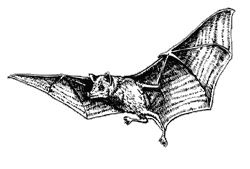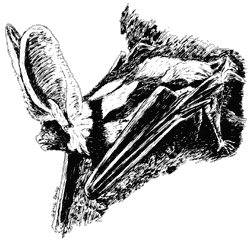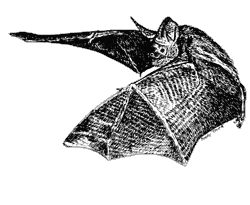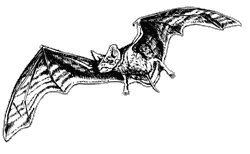Bats
Janet Tyburec
Bats make up one of the most diverse orders of mammals. Nearly 1000 species account for almost a quarter of the world’s mammal fauna — about 1 out of every 4 mammals on our planet is a bat! Global bat diversity is due in large part to the length of time bats have been on Earth. Paleontological study indicates that bats flew through the night skies over 50 million years ago. Fossil bats are very similar to those that exist today, giving few clues about their early ancestors. Fully evolved bats lived at a time when the predecessors of the horse were small, 3-toed, fox-like animals trotting around in the Eocene swamps.

Over the millennia, bats have evolved to live on every continent except Antarctica, and in every habitat except the most extreme polar and desert regions. As a result of this radiation, bats exhibit astounding diversity. Species range in size from giants with 6-foot wingspans to Lilliputians that weigh less than a penny. Some bats are jet black and some are snow white; others have pelts from yellow, orange, and red through blue-gray. Bats employ almost every mammalian feeding strategy. Some are herbivores that visit plants and survive on flower nectar or fruit, and some even feed upon leaves. Insectivorous bats hunt flying insects or pluck stationary insects off the ground or foliage. Some bats are true carnivores that catch lizards, frogs, small rodents, birds, and even other bats; several species have evolved adaptations that allow them to fish for small minnows and aquatic invertebrates. And there are 3 species of bats that are, in a sense, parasitic; they are true vampires, surviving only on the blood of other animals.
The bat order is divided into 18 different families with all members of each family sharing similar evolutionary paths, physical features, adaptations, and sometimes even foraging strategies. Some families are large, containing hundreds of species that can be found worldwide; other families are small, with some made up of a single species that is not closely related to any other species.
Wherever bats occur, they are masters of their domains, able to navigate in the pitch darkness of deep caverns and adapted for survival in a nocturnal aerial niche like no other mammals. Bats are also cloaked in myth and superstition; as a result, misinformation about them abounds. The truth is, bats are not all blood-sucking vampires, dirty disease-carriers, or blind and likely to get tangled in hair. Worldwide, bats are efficient predators of nocturnal insects, including numerous costly agricultural pests, and they pollinate the flowers and disperse the seeds of hundreds of ecologically and economically important plants. Bats continue to astound scientists with their abilities and adaptations. Yet in North America, they rank among the most threatened land mammals, with over half of the 45 species officially listed as threatened or endangered or as candidates for such listing. It is only through information and education that we can reverse their trend toward extinction and begin to appreciate the roles bats play in healthy ecosystems.
Ghost-faced Bats
This small family of bats, with 2 genera and 8 species worldwide, is restricted to warm tropical regions of the New World (North, Central, and South America). These bats typically roost in hot, humid caves, forming colonies in the hundreds to thousands of individuals. Bats in this family have flaps and folds of flesh around their mouths, often set off by large, obvious hairs or whiskers, character-istics that give them their common family name. It is suspected that these oral structures help to focus their echolocation calls or perhaps to funnel insects into their mouths. In addition, some family members have wing membranes covering the dorsal surfaces of their fur and meeting at midline along their backs, perhaps increasing the surface area of the wing membranes and thus helping the bats to dissipate heat. Bats in this family have long, narrow wings and are fast flyers, typically hawking (swooping hawk-like to catch) insects near pond surfaces.
Representative Sonoran Desert species:
Peter’s ghost-faced bat (Mormoops megalophylla)
Order: Chiroptera
Family: Mormoopidae
Description
The genus Mormoops has only 2 species, one of which, Peter’s ghost-faced bat, lives in the Sonoran Desert. These bats have leaf-like folds and flaps on their faces, forming virtual megaphones, to help amplify and direct their high-frequency echolocation calls. These are medium-sized bats with wingspans of about 14 1/2 inches (37 cm). The tails of ghost-faced bats do not extend past the tail membranes, nor are they completely enclosed by the membranes. Instead, the tails project upwards from the top surface of the membranes near the middle. Ghost-faced bats are a reddish-brown in color with similarly colored wings and membranes, though some individuals do become bleached due to high ammonia concentrations in their roosts.
Range
Ghost-faced bats are found from southern Texas and Arizona south throughout Mexico and into Central and northern South America. They are more common in arid regions, though they have been found in tropical dry forests and more humid areas.
Habitat
These bats roost in large colonies in caves or mines and sometimes old tunnels and abandoned buildings. They forage on insects while in flight, and generally hunt for insects high above the ground instead of near foliage or water. Their narrow wings allow for strong, fast flight and help them to travel long distances and pursue flying insects. Ghost-faced bats are not well suited for maneuvering in a cluttered environment.
Life History
Ghost-faced bats live where winters are not very cold. They appear to remain active year-round, neither hibernating nor migrating. Very little is known about their current distribution and habitat requirements, and much more study of their life history is needed.
New World Leaf-nosed Bats (American leaf-nosed bats)
This is arguably the most diverse family of bats in the world, with 51 genera and 147 species. Though other families are larger, none other exhibits the variation in size, habitat, behavior, or physical traits found in the New World leaf-nosed bats.
As their common name implies, bats in this family are found only in the Americas. Members of this family are generally separated into 6 sub-families, based largely upon their common diets. Some leaf-nosed bats have adapted an insectivorous diet which leans toward carnivory, while larger members of the family take frogs, mice, birds, and other vertebrates. Other leaf-nosed bats are strictly nectar-feeders, and as such are responsible for the pollination of many tropical plants. Still others are strictly fruit-eaters, and thus essential seed dispersers. Some bats survive on either fruit or nectar during different seasons; others are specialists, feeding on just one type of fruit that is available throughout the entire year. True vampires are also grouped into this family. Only 3 species of vampire bats exist — 2 specialize on the blood of birds, and 1 preys on both birds and mammals.

Lesser long-nosed bat
The diversity of leaf-nosed bats increases with proximity to the equator. Yet they can be found in all habitats from arid deserts to lush lowland tropics, and from montane deciduous forest to high-altitude cloud forests. They roost in caves and mines, cliff crevices, tree hollows, and even in human dwellings. Several species build their own roosts by biting and folding the large leaves of bananas (Heliconia spp.) and some palms. Among the 4 species of leaf-nosed bats that range north of the U.S.-Mexican border is an insect-eater living in the Colorado River valley; 3 are fruit- and nectar-eating bats that follow the bloom of columnar cacti of the Sonoran Desert each spring along their northward migrations. In the fall, they rely upon numerous blooming agave species to fuel their return trips south.
Representative Sonoran Desert species:
California leaf-nosed bat (Macrotus californicus)
Lesser long-nosed bat (Leptonycteris curasoae)
Mexican long-tongued bat (Choeronycteris mexicana)
Order: Chiroptera
Family: Phyllostomidae
Spanish name: murciélago
Description
The leaf-nosed bat has a triangular fleshy growth of skin, called a noseleaf, protruding above the nose. All 3 leaf-nosed bats of the Sonoran Desert weigh between 0.4 and 0.7 ounces (12 and 20 gm), have wingspans of more than 12 inches (30 cm) and body lengths more than 2.5 inches (6 cm), and are brown in color. The California leaf-nosed bat has ears longer than 1 inch (2.5 cm). Other leaf-nosed bats have much smaller ears and long, slender snouts. The lesser long-nosed bat does not have a tail. The Mexican long-tongued bat has a tiny tail, less than 1/5 inch (.5 cm) long.
Range
American leaf-nosed bats are found from the southwestern United States through the New World tropics. The California leaf-nosed bat lives throughout the Sonoran and Mohave deserts. The lesser long-nosed bat is found from southern Arizona and Baja California del Sur south along western Mexico to Central America, and the Mexican long-tongued bat occurs from southeastern Arizona south to southern Mexico.
Habitat
The California leaf-nosed bat, an insectivorous species, inhabits desert scrub, roosting by day in mine shafts. It does not hibernate nor migrate, so the warm mine shafts are critical for its survival in the northern part of its range. The other two species are nectar and pollen feeders. They are migratory and depend on chiropterophilous (adapted for pollination by bats — literally, “bat loving”) plants for their survival. Lesser long-nosed bats follow the flowering of cardón, organ pipe cactus, and saguaro north through the desert in the late spring. Then they shift to feeding on agaves at higher elevations during the summer, returning to southern Sonora by fall. The lesser long-nosed bat assembles in day roosts of hundreds or thousands in caves and mines. The Mexican long-tongued bat is less common in the desert. Its primary habitat is at higher elevations where it too migrates, following the flowering of chiropterophilous plants. It roosts in small numbers, frequently at entrances to caves and mines.
Life History
The California leaf-nosed bat feeds on large insects that it gleans from foliage, or even from the ground. It does not alight to capture its prey, but deftly hovers above it and snags it off the substrate. It then carries its prey to an open roost such as a porch or open building to dismember, then consume it. This bat has an unusual reproductive pattern. After breeding takes place in the fall, the resulting embryos develop very slowly until March, when growth continues at a more normal rate before birth in May or June. Twins are common.
The relationship between the two nectarivorous bats and their chiropterophilous plants is not accidental. The bat receives a food reward in the form of fructose- and glucose-rich nectar and protein-rich pollen. The plant gets a pollinator that transports pollen from it to another of its own species. The bats and plants also have co-evolved features that support this relationship. The plants flower or exude nectar at night when bats are active. They attract bats with flowers that are light colored and easily seen at night and that have a strong musty or sour odor which the bats can smell in the night air. The flowers, frequently bowl-shaped and sturdy, are usually at the top of the plants or far out on limbs, so that bats can easily get to them without becoming tangled in thorny vegetation or having to slow down to navigate among branches. While getting to the large nectar reward in the flowers, a bat gets covered with pollen. The bat consumes any pollen that is not left at some other plant when it grooms itself back at the roost. Each nectarivorous bat has a long, slender snout and a long, extensible tongue with a brush-like tip for lapping nectar. long, extensible tongue with a brush like tip for lapping nectar.

>California leaf-nosed bat
The California Leaf-nosed Bat: Uniquely Adapted for Arid Lands
Although they live in some of North America’s most extreme deserts, California leaf-nosed bats have never been seen drinking and can easily live in a laboratory without water for at least 6 weeks at a time.
This species also ranks among the world’s most amazing nocturnal hunters. Helicopter-like flight enables California leaf-nosed bats to pluck insects directly from foliage without even having to slow down. With their huge ears, they can detect and locate sounds as faint as a cricket’s footsteps or a caterpillar’s munching mandibles.
Their large eyes provide night vision on a par with our best military goggles, enabling them to spot tiny sleeping insects illuminated by nothing more than faint star-light. In fact, they prefer to rely on vision alone except when confronted by total darkness. In such situations, they simply switch to echolocation, with which they can detect objects as small as seven-thousandths of an inch (0.19 mm) in diameter. They also use special whispering signals that can be heard no more than 3 feet (1 m) away, preventing most prey from anticipating their approach until it’s too late.
Their short, broad wings and slow, maneuverable flight are not suited to long-distance travel. They cannot migrate long distances to avoid cold winters, nor can they hibernate. These bats are truly desert-adapted.
Vesper Bats (plain-nosed bats, evening bats)

Big brown bat
Vesper bats make up the largest family of bats, and the second largest family of mammals. (Only the Muridae family, the Old World rats and mice, is larger.) More than 40 genera are commonly recognized and some 330 species are found worldwide. Bats from this family are largely insectivorous, though some have evolved long feet and sharp claws with which they fish for small minnows and fish from still ponds. Vesper bats have plain faces with simple noses largely devoid of flaps or folds. Their ears are variable in length — some are tiny, hardly protruding from their fur; others are nearly as long as their bodies.
These bats live in many habitats and use every imaginable kind of roost. Species from this family are most numerous in temperate regions where the bats survive cold, snowy winters when few insects are available by hibernating deep within caves or mines that offer stable temperatures above freezing. Some hibernating species spend up to 8 months of the year sleeping underground.
Vesper bats are also among the most colorful bats, with fur that ranges from solid reds, browns, yellows, and grays to multicolored, spotted and painted. The most colorful bats are those that roost in tree foliage or cliff crevices where their markings help them blend in with bark, leaves, or areas of light and shadow.
Representative Sonoran Desert species:
California myotis (Myotis californicus)
Cave myotis (Myotis velifer)
Yuma myotis (Myotis yumanensis)
Fish-eating bat (Myotis vivesi)
Townsend’s big-eared bat (Corynorhinus townsendii)
Big brown bat (Eptesicus fuscus)
Spotted bat (Euderma maculatum)
Pallid bat (Antrozous pallidus)
Western pipistrelle (Pipistrellus hesperus)
Order: Chiroptera
Family: Vespertilionidae
Spanish names: murciélago
Description
The Myotis, Pipistrellus and Eptesicus have small ears. A Myotis bat has a pointed flap of skin projecting vertically in the ear. Bats of the other two genera have rounded flaps. The Myotis are very difficult to differentiate. The cave myotis tend to have bare spots between their shoulder blades. The fish-eating bat has very large gaff-like feet. The Pipistrellus is the smallest member of the group, at 1/10 oz (3 gm). Eptesicus, at 1/2 oz (16 gm), is larger than all the Myotis except for the fish-eating bat. The color of Pipistrellus is buff, with contrasting dark black ears and wing and tail membranes. The Eptesicus and Myotis are generally brown.
The remaining 3 species of evening bats have very large ears, more than 1 inch (2.8 cm) long. The ears of Euderma and Plecotus are rolled up around the head when the bat is at rest and then inflated with blood when the bat is active. The spotted bat is the most strikingly marked; it is pitch black with three white spots on its back and has pink ears. The pallid bat is a pale cream color or yellow. The Townsend’s big-eared bat is brown.

Western pipistrelle
Range
Most vesper bats are found throughout the Sonoran Desert, although the Yuma myotis, the cave myotis and the Townsend’s big-eared bat are not found in the westernmost, driest parts of the desert. The fish-eating bat is only found along the coast of the Gulf of California. The spotted bat is widely distributed from northern Mexico to southern British Columbia, but is not abundant anywhere in its range.
Habitat
The California myotis, cave myotis and pipistrelle forage in and above desert scrub for flying insects. The Yuma myotis forages directly over water, often within a few centimeters of the surface. The pipistrelle frequently forages while the sky is still light at dawn and dusk. The California myotis and the pipistrelle roost by day in the fissures of rocky cliffs, while the cave bat (cave myotis) roosts in caves and mines. All sometimes use buildings, particularly at night, though the Yuma myotis seem to prefer buildings during the day, too. The winter roosts of the myotis are cool caves, mines or buildings. Male pipistrelles can frequently be seen foraging on warm winter evenings in the desert, while the females are hibernating at higher, cooler elevations.
The big brown bat is usually associated with man-made structures in the desert, although it has been recorded roosting in woodpecker holes in saguaros. It forages for flying insects in the summer and migrates to higher elevations in the winter to hibernate.
Fish-eating bats catch small fish at the surface of calm coastal waters. They roost by day in the rock rubble and talus slopes on the gulf islands or in remote coastal areas. At night they rest in sea caves while consuming their catches.
Townsend’s big-eared bats roost by day hanging from the open ceilings of caves or mines. They hibernate in cold (32° to 54°F; 0° to 12°C) caves, lava tubes or mines.

Spotted bat
The pallid bat roosts by day in rock fissures in cliff walls or in tight crevices within buildings. It forages low over the ground, frequently alighting to capture prey such as sphinx moths, katydids, June beetles, and even scorpions. Its winter habits are poorly known. It is believed to migrate short distances to suitable sites for hibernation.
The spotted bat is thought to roost by day in rock fissures in high cliff walls, although it is uncommonly seen and its requirements not well known. Cliffs and water courses in arid, rocky, mountainous areas seem to be important features of spotted bat habitats. These bats are late flyers, generally emerging well after dusk. They appear to forage mainly on moths, which they intercept at great heights. They visit waterways to drink after midnight.
Life History
The evening bats are insectivorous, with the exception of fish-eating bats. All evening bats use echolocation to find their prey — even the fish-eating bat. Echolocation involves emitting ultrasonic sounds (generally frequencies of 20,000 to 80,000 Hz) from the voice box and listening for the echoes that bounce off objects in the environment. A bat can determine size, shape, direction of travel and even texture of its prey from this echo information. It can even detect something as narrow as a human hair. The fish-eating bat can locate tiny fish at the surface of the water from the ripples they cause, and gaff them from the water surface with its huge clawed feet.

Pallid bat
Generally, once an insect has been detected and found to be suitable it is captured and eaten. However, some moths use thoracic “ears” or vibration-sensitive palps to listen for the ultrasonic calls of bats, and take evasive action by flying about erratically or diving into dense shrubbery. Moreover, some moths have a “jamming” mechanism that mimics the echoes of a bat at very close range to prey, and causes the confused bat to then break off its attack. To counter this, some bats have evolved big ears and quiet voices to sneak up on these “listening” moths. And some bats, such as spotted bats, emit low frequency sounds, lower than the moth’s “ears” can hear, thus avoiding detection. This evolutionary war game is one of the finer examples of predator/prey interactions.
The reproductive pattern of evening bats usually involves mating in the fall or right before hibernation. The sperm is stored in the female’s uterus until spring when ovulation and fertilization occur. Births are usually in late June and early July. Baby bats are born rump first (breech birth) while the mother hangs from her thumbs in a head-up position and catches the baby in her tail membrane. Most bats give birth to just a single offspring, but twinning is common in Antrozous and Eptesicus, especially east of the Mississippi for the latter. The females are usually in maternity colonies of a few females (California myotis) to 15,000 individuals (cave myotis). Maternity roosts are typically warm. The males during this time are usually roosting separately in cool roosts where they conserve energy and water through a daily torpor. The young stay in the roosts until they are about 6 to 8 weeks of age.
Free-tailed Bats
Free-tailed bats are found worldwide from warmer temperate regions to the tropics. Bats from this family are split into 13 genera with about 90 species. Every bat in this family has a thick tail that protrudes freely from the tail membrane for at least N of its length. These bats — high, fast flyers with long, narrow wings — are capable of making annual migrations of 500 miles (800 km) or more to overwintering grounds that are warm enough for them to feed and remain active.
Recent research on the common Brazilian free-tailed bat (Tadarida brasiliensis), also called Mexican free-tailed, indicates that it is an important predator of costly crop pests. In Central Texas, free-tailed bats prey on large flocks of migratory moths whose larvae attack cotton and corn. Though these bats do not range much further north than Oklahoma, they prevent hundreds of millions of moths from reaching the grain belts and bread baskets of North America, protecting farmers as far north as the Canadian border. Sadly though, Brazilian free-tailed bats have experienced some of the most precipitous declines documented for any North American bat species. In 10 key caves surveyed in Mexico, half have lost over 90 percent of their bat populations, and 4 of the remaining 5 caves have lost more than 50 percent of their populations. Similar declines have been recorded at Carlsbad Caverns in New Mexico and Eagle Creek Cave in Arizona. Protection for remaining colonies is essential for this highly beneficial species’ continued survival.
Representative Sonoran Desert species:
Mexican free-tailed bat (Tadarida brasiliensis)
Big free-tailed bat (Nyctinomops macrotis)
pocketed free-tailed bat (Nyctinomops femorosaccus)
western mastiff bat (Eumops perotis)
Underwood’s mastiff bat (Eumops underwoodi)
Order: Chiroptera
Family: Molossidae
Description

Mexican free-tailed bat
Free-tailed bats’ tails extend more than one third beyond the tail membranes; most other bats have tails that are completely enclosed within the tail membranes. All free-tailed bats have very long narrow wings and forward-projecting ears. The western mastiff bat is the largest bat in the Sonoran Desert and the United States. Its wingspan is more than 20 inches (50 cm) and it weighs about 2 ounces (60 gm). The Underwood’s mastiff is only slightly smaller. The American free-tail is the smallest free-tail at 0.4 ounces (12 gm) and a wingspan of 12 inches (30 cm). The big free-tail and pocketed free-tail are in between, at 0.8 ounces (25 gm) and 0.5 ounces (16 gm) respectively.
Range
These free-tails are found throughout the Sonoran Desert, with one exception. Underwood’s mastiff occurs only in arid western Sonora to barely north of the Arizona border.
Habitat

Western mastiff bat
The free-tails are strong, fast, long-distance flyers. Mexican (Brazilian) free-tails can fly 60 miles (100 km) per hour and forage nightly as far as 50 miles (80 km) from their roosts at altitudes of up to 9800 feet (3000 m). The Eumops sp. and Nyctinomops sp. roost in small colonies in rock fissures in high cliff faces. The Eumops need at least 20 feet (6 m) of vertical drop from their roosts to gain enough speed for flight. If on the ground, they need to climb up a vertical surface in order to launch into flight. The smaller pocketed free-tail sometimes roosts in caves.
The Mexican (Brazilian) free-tail roosts in large colonies, typically in caves, but sometimes in mines, buildings or bridges. Big colonies may include up to one million bats in the summer. Historically, one particular colony of 20 million Mexican free-tails existed in one cave in Arizona. Most of the Arizona colonies migrate south to Mexico in the winter. They have been recorded as migrating as far as 800 miles (500 km).
Life History
With the exception of the Mexican free-tail, the natural history of the Sonoran Desert free-tails is not well known. Most seem to migrate to warmer climates in the winter. They are all insectivorous, and although moths are the specialty of the Mexican free-tail, any night-flying insect is game. Free-tails generally forage well off the ground; the western mastiff regularly forages at 100 to 200 feet (30 to 60 m) above ground level. A single free-tail baby bat is born during the summer. Unlike the young of most bat species, young Mexican free-tailed bats roost separately from their mothers. Babies are located in the highest reaches of the cave, where temperatures are the highest, and often in small ceiling domes where dense clusters help to trap hot air. The incubator-like conditions are essential for rapid growth and survival. In the large maternity colonies of Mexican free-tails, the mother evidently finds her own youngster among the thousands by recognizing its individual location call. The adult males roost separately during this part of the year.










